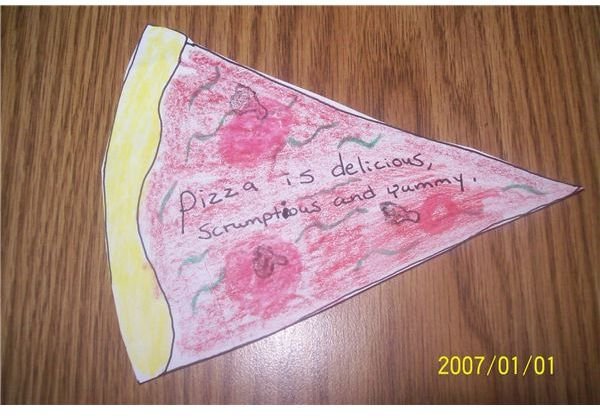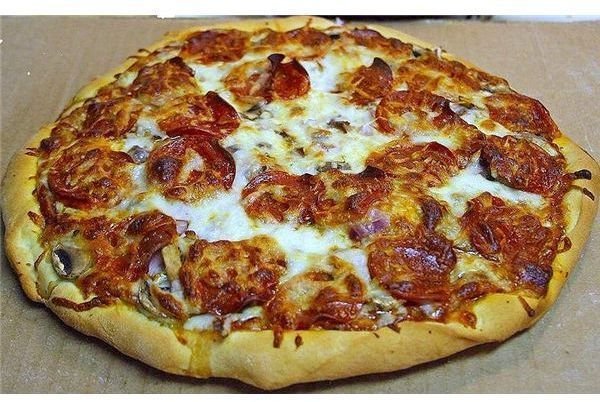A Pizza Lesson Plan That Brings Pizazz to Your Classroom
Pizza in the Classroom
The delicious combination of dough, sauce, cheese and toppings brings a smile to any child’s face. Pizza is one of foods children love. This October let your students experience some hot pizza fun not just in the lunchroom but in the classroom too.
Objectives
- Find Italy on a world map
- Name where pizza originated from
- Correctly sequence steps to make a pizza while making a real mini pizza
- Demonstrate how to make fractions using pizza and toppings with 80 percent accuracy
- Recognize simple fractions with 85 percent accuracy
- Demonstrate knowledge of place value to the tenths place with 90 percent accuracy
- Correctly identify adjectives with 75 percent accuracy
Where Did Pizza Come From?
Begin the lesson with a riddle.
I was first discovered in Naples Italy.
I am chewy and hot and kids like me a lot.
You roll me out of dough, don’t you know.
You can put any toppings you want on me.
What am I?
Some suggested answers could be:
- Cupcakes
- Popcorn
- Pizza
- Spaghetti
After allowing the students to guess pizza, show them world map and ask a volunteer to find Italy. Point out that Italy is a peninsula because it is a piece of land almost entirely surrounded by water and connected to a larger piece of land.
Explain that pizza first originated in Naples, Italy in the early 1889 when a baker tried to make a food using the same colors as the Italian flag. The flag is red, white and green. If possible, show students a picture of the flag.
The baker used red tomatoes, white mozzarella cheese and green basil leaves and that is how pizza was first created. The word pizza means “pie” in Italian. Today pizza is one of America’s favorite foods. Ask children what their favorite kind of pizza is. Read “Little Nino’s Pizzeria,” by Karen Barbour.
Pizzeria Place Value Center
Make your classroom look and feel like an Italian Pizzeria while students are learning place value skills at centers. Kids will love pretending to be the bakers and customers of a pizza parlor while they are practicing important math skills.
Materials:
- Ten pizza boxes
- Nine single pieces of pizza cut from construction paper and laminated
What to do:
Purchase (or ask to have them donated) ten pizza boxes and write “ten pieces of pizza,” on the each box with a black marker. Cut-out nine pizza slices from construction paper, laminate the slices, and place them in the pizza parlor.
Place two students at a time at the pizza parlor place value station. One child will order a certain number of pieces of pizza and the other student must give him or her the correct number of boxes and pieces. For example, the student would ask for 45 or 14 pieces of pizza. The baker would hand the customer four boxes and five single pieces (45) or one box and four single pieces (14).
Pizza Parlor Make Me a Pizza Center
Children learn fractions while pretending to make pizzas for customers.
Materials:
- 8 pizza cut-outs
- Several topping cut-outs
- Pizza box
Instructions:
Provide pizza cut-outs and toppings for the fraction center. The student pretending to be the customer will order a certain number of pieces of pizza and instruct the baker to put a certain topping on so many of the pieces.
For example, a child may ask for five pieces of pizza with pepperoni on thee of the pieces. The baker will put five pieces of pizza in a pizza box and place pepperoni on three of the pieces. Both children will then write the correct fraction on a whiteboard and compare answers. The teacher walks around the room and checks for correct answers.
Mini Pies
Children learn the steps it takes to make a real pizza while enjoying a tasty, yummy snack.
Ingredients:
- Biscuits
- Pizza sauce
- Mozzarella cheese
- Pepperoni
- Canadian bacon
- Mushrooms
- Peppers
- Onions
- Foam bowls to place the ingredients in
- Cookie sheet
- Oven
How to Make:
Give each child a biscuit and encourage them to roll it out as flat as possible, and place the sauce and the desired ingredients on the dough. The teacher bakes the pizza in the oven set at 400 degrees Fahrenheit for 8 to 10 minutes or until the cheese is melted.
After the students are finished eating, have them write down the steps involved in creating their pizza and draw a picture of their pizza with crayons on a white piece of paper.
For example:
- Pat the biscuit until it is flat.
- Put two tablespoons of pizza sauce on the dough.
- Add pepperoni, mushrooms and peppers.
- Sprinkle with Mozzarella cheese.
- Bake in the oven at 400 degrees for 8 to 10 minutes.
Parts of Speech Pie

Children review the parts of speech with this pizza activity. The teacher will give each student four pizza slices cut from white construction paper.
Students copy the sentences and fill in the blanks with an adjective, verb, noun or adverb from the word bank.
They may use more than one adjective and noun on two of the pizza cut-outs. Decorate the pizzas with crayons and markers. When finished, the teacher can place them around the room or on the bulletin board to give the classroom pizazz!
- Pizza is _________. (adjective)
- I like to put _________on my pizza. (noun)
- I _________ the dough. (verb)
- I eat my pizza __________. (adverb)
Word Bank:
Adjectives:
- Delicious
- Hot
- Spicy
- Scrumptious
- Yummy
Verbs:
- Smash
- Roll
- Toss
- Knead
- Flatten
Nouns:
- Pepperoni
- Sausage
- Peppers
- Mushrooms
- Cheese
- Onions
Adverb:
- Slowly
- Quickly
- Quietly
- Loudly
- Fast
This October, cook up some fun in your classroom with a scrumptious pizza lesson plan that reinforces important math and language skills. Children will love making and eating pizza while they are learning important facts about one of America’s favorite foods.
References
Activities and photo by Lisa King, all rights reserved.
Author unknown, “The Story & History of Pizza,” Chicago Public Schools I University of Chicago Internet Project (CUIP), https://cuip.uchicago.edu/wit/99/teams/pizza/pizzastory.htm
Barbour, Karen. Little Ninos Pizzeria. Sandpiper. March 15, 1990.
Image: Pepperoni pizza by Jon Sullivan under Public Domain
Sample contents.
